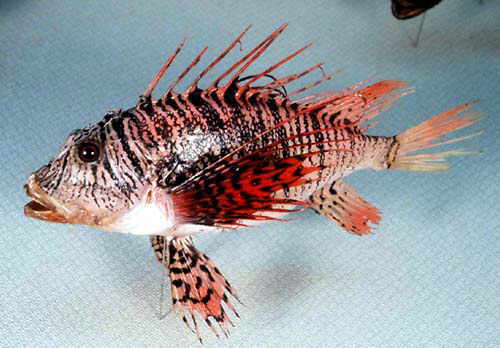|
| 질의: Black lion | 결과: 49번째/124 | |
쏠배감펭 (동물이름사전)
| 제목: | 쏠배감펭 (동물이름사전)
| | 올린이: | Administrator (kusnij@naver.com)
| |

| 해상도: 500x348
파일크기: 28441 Bytes
등록시간: 2004:05:17 10:19:57
|
쏠배감펭 (동물이름사전)
(사진: 이화여대 사이버자연사박물관 http://emei.ewha.ac.kr:8087/servlet/Museum_Index)
쏠배감펭
영명: Luna lion fish, Volitan Common Lion, Common Lionfish, Turkeyfish, Butterfly Cod, Devilfish, Black Volitan Lion, Butterfly fish, Fireworks fish, Sting fish, Lion fish
학명: Pterois lunulata (Temminck & Schlegel, 1843)
[분류] 경골어류(硬骨魚類) 양볼락목(Scorpaeniformes) 양볼락과(Scorpaenidae)에 딸린 바다 물고기.
[방언] 쫌뱅이(순천), 북제어, 산방우럭, 심방우럭(우도), 쏘치우럭(한림)
[형태] 몸길이 30cm. 몸은 긴 타원형이며 옆으로 납작하다. 등지느러미와 가슴지느러미가 길며 가슴지느러미 막은 움푹 들어가 있다. 머리, 배, 가슴에는 검은 점이 없고 등지느러미의 여린줄기, 꼬리지느러미에도 대부분 검은 점이 없는 것으로 유사종과 구분된다. 몸 색깔은 연한 적색으로 옆구리에는 흑갈색의 가로 줄무늬가 많다. 머리 꼭대기는 울퉁불퉁하여 평탄하지 않고, 두 눈 사이는 매우 패여 있고, 눈 위의 피질판은 눈지름보다 짧다. 양턱은 같은 길이이며, 아래턱 아랫부분에는 혹 모양의 돌기가 발달되어 있다. 입은 크고, 양턱에는 융털모양의 이빨이 있다. 코와 눈 주위에는 가시들이 많이 있다. 성어는 크기 가 30cm정도 된다. 가슴지느러미가 크며 등지느러미의 가시는 서로 떨어져 있어서 사자의 갈기처럼 보인다. 얼른 보기에는 훌륭하게 몸 치장한 인디언 추장의 모습을 연상시키기도 한다.
[생태] 등지느러미 가시에 독샘이 있어서 찔리면 몹시 아프다. 쏨뱅이목 양볼낙과 쏠배감펭속으로 연안의 암초 지대에 서식한다. 여름철에 젤라틴 질로 싸인 부유성 알 덩어리를 낳는다. 해면에 산란한다. 등지느러미의 가시에는 독선이 있으며 위협을 느끼면 긴 지느러미를 세워 자신을 보호하는 습성이 있다. 먹이는 작은 물고기나 갑각류 등이다. 완만한 움직임으로 우아하게 헤엄쳐 다니지만 전신을 덮고 있는 지느러미에는 독이 있다. 저층어류로 주로 연안 암초지대의 바닥에서 관찰된다.
[분포] 우리 나라 남부, 제주도, 일본, 동 인도제도, 대만, 태평양, 호주, 홍해, 남아프리카.
[기타] 무척 우아하고 아름다운 빛깔과 모습을 한 물고기이기 때문에 관상용으로 수족관에 기른다.
|
댓글 |
|---|
| | 손님 |
|
| 쏠배감펭 - Pterois lunulata (Common Lionfish) / 양볼락목(Scorpaeniformes) 양볼락과(Scorpaenidae) |
^o^
동물그림창고 똑똑전화 누리집
^o^
|
|
|